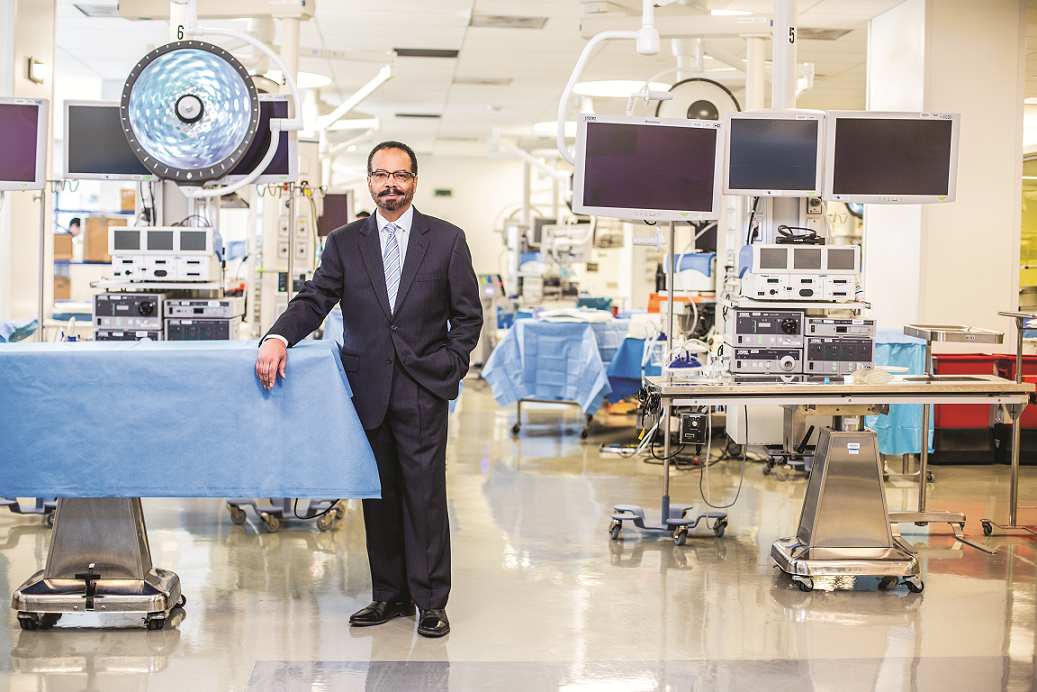Wanted: Invention-Minded Physicians
Dr. Roderic Pettigrew seeks to train problem-solving “physicianeers”
By Hannele Rubin

Roderic Pettigrew, Ph.D., M.D. ‘79
Roderic I. Pettigrew, Ph.D., M.D. ’79, first discovered his enthusiasm for engineering as a child in semi-rural Albany, Ga., building bows and arrows from Chinaberry tree branches and a bicycle inner tube.
That enthusiasm was also evident in a memorable event when his sixth-grade science teacher explained Bernoulli’s principle — how differential airspeed relates to a difference in pressure to achieve lift.
“That’s how birds fly!” Dr. Pettigrew exclaimed, remembering his excitement. “That’s how airplanes fly! That was a pivotal moment for me because it taught me a scientific principle. As a youngster, I could see its application in nature and in life, and I fundamentally then understood flight, why paper flies out of the open window of a moving car, and even how a vacuum cleaner works.”
STAYING ENERGIZED
The excitement of intellectual inquiry has kept him energized at some of the country’s most elite educational and research institutions, from studies in physics and nuclear medicine to founding and leading an innovative governmental research institute and now, new academic programs at Texas A&M University.
Along the way, Dr. Pettigrew’s long career revealed its unifying theme — bringing seemingly disparate disciplines together at the intersection of invention and healing. Others took notice: In 2013, the American Institute of Medical and Biological Engineering awarded him its highest honor, the Pierre Galletti Award. In 2014, the Academy for Radiology and Biomedical Imaging Research awarded him its inaugural Gold Medal. In 2017, the Radiological Society of North America awarded him it’s gold medal. In 2019, the National Academy of Engineering recognized his “outstanding contributions to technology research, policy, and national and international cooperation” with one of its oldest honors, the Arthur M. Bueche Award.
Dr. Pettigrew’s attraction to convergence was among the reasons he decided to pursue an M.D. at the Miller School of Medicine after earning a Ph.D. from the Massachusetts Institute of Technology in applied radiation physics in 1977.
“I decided that being a scientist who worked on medical problems in graduate school at MIT, was the start of what I was pursuing,” he said. “I wanted to work on the problems from the standpoint of a physicist and a physician.”
Dr. Pettigrew chose an accelerated program at UM that allowed a scientist with a Ph.D. to earn an M.D. over the course of 24 months. “It turned out to be the most difficult educational program I ever pursued,” he said.
DRAMATIC INCREASES
In Dr. Pettigrew’s 15 years as the founding director of the National Institute of Biomedical Imaging and Bioengineering (NIBIB) at the National Institutes of Health, he is credited with dramatically increasing the convergence of engineering and the life sciences nationally to advance medical innovations. These included the specific examples of a microchip that detects a single cancer cell among a billion normal cells in a routine blood sample, a painless biodegradable microneedle vaccine patch that does not require refrigeration, could be sent in the mail and allows self-administration, and a groundbreaking treatment for spinal injury paralysis.
At the end of 2017, he moved to Houston to lead a new integrated engineering and medical school initiative at Texas A&M and Houston Methodist Hospital, called EnMed — for Engineering Medicine — in which students simultaneously earn both M.D. and M.E. degrees in only four years. The graduates, called Physicianeers, will be trained to innovate and invent a solution to a health care problem.
This idea is not just marketing, Dr. Pettigrew noted: an invention is a graduation requirement. “It could be something as simple as devising a better way to draw blood, or something more complicated, such as doing a complete blood analysis without having to draw blood.”
Unmet needs in medicine range from “modest problems to daunting challenges,” he added. “Our goal is to develop a new kind of physician — invention-minded and innovation-centric. ‘Physicianeers’ will be a new cadre of doctors trained to not only recognize, diagnose and treat problems, but also think of much better ways to diagnose, treat and prevent them. The goal is to help transform the health care ecosystem so that we all have good health through the entirety of our lives.”


